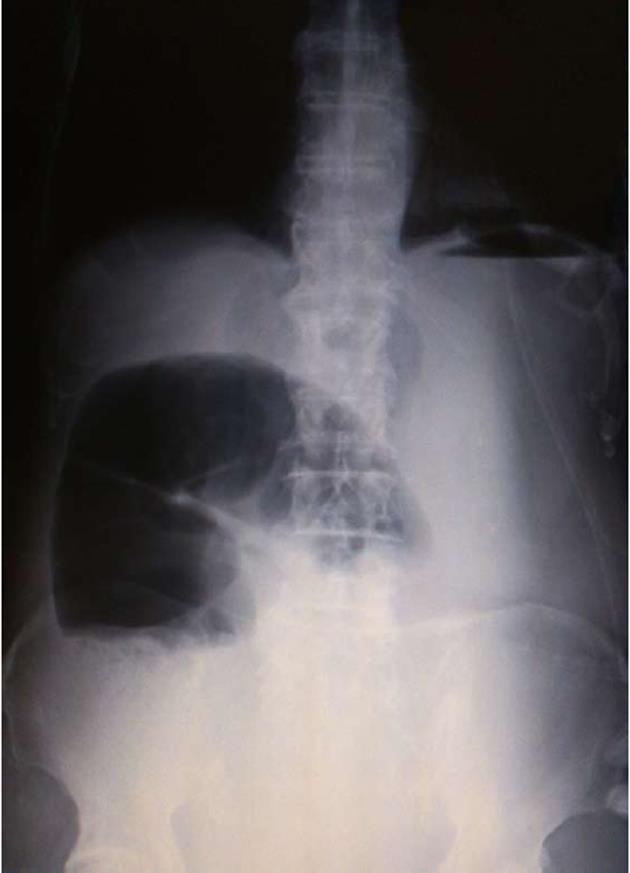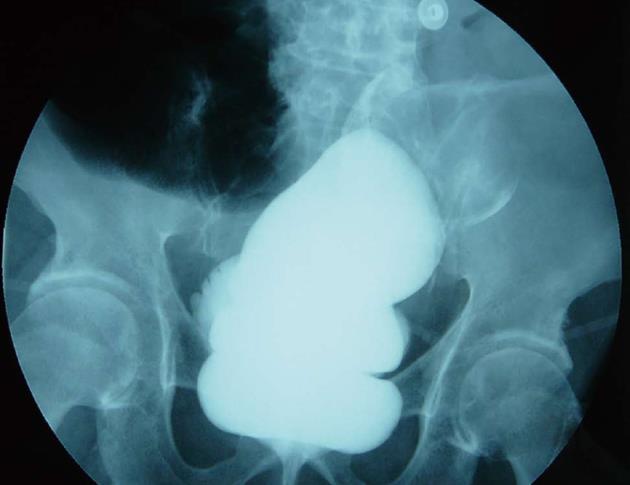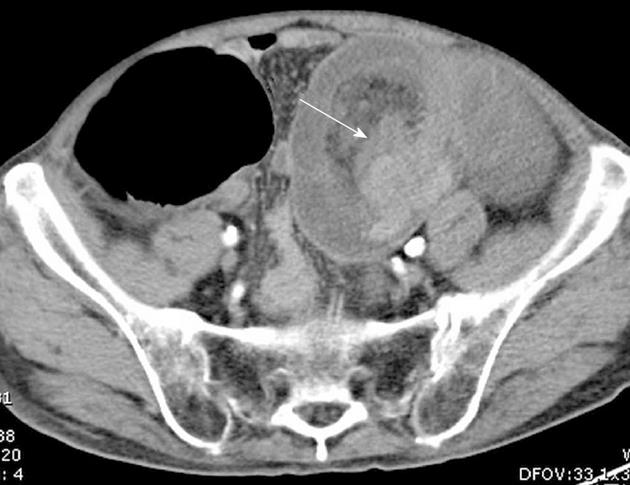Published online Jun 14, 2013. doi: 10.3748/wjg.v19.i22.3517
Revised: April 2, 2013
Accepted: April 10, 2013
Published online: June 14, 2013
The occurrence of adult intussusception arising from colorectal cancer is quite rare. We present the case of a 76-year-old man with sudden abdominal pain and vomiting. Clinical symptoms included severe abdominal distension and tenderness. Computed tomography scan of the abdomen revealed left-sided colocolic intussusception with a lead point. The patient underwent a left hemicolectomy with right transverse colostomy. Pathologic evaluation revealed moderately differentiated adenocarcinoma invading the muscularis propria; the regional lymph nodes were negative for cancer cells. The postoperative course was uneventful.
Core tip: Intussusception is a common cause of bowel obstruction in pediatric patients, but it is rare in adults and it is often difficult to diagnose. We present the case of a 76-year-old man with sudden abdominal pain and vomiting. The patient underwent a left hemicolectomy with right transverse colostomy. This article reports the complete diagnosis and management of the patient.
- Citation: Xu XQ, Hong T, Liu W, Zheng CJ, He XD, Li BL. A long adult intussusception secondary to transverse colon cancer. World J Gastroenterol 2013; 19(22): 3517-3519
- URL: https://www.wjgnet.com/1007-9327/full/v19/i22/3517.htm
- DOI: https://dx.doi.org/10.3748/wjg.v19.i22.3517
Intussusception is most often encountered in infants and children, and only 5% of cases occur in adults. It accounts for about 1% of all cases of adult bowel obstruction. Adult intussusception of the colon is rare and related to malignant lesions[1]. We describe a case of adult intussusception of the transverse colon caused by a malignant tumor in an elderly man preoperatively diagnosed by X-ray, barium enema and computed tomography (CT) scan.
A 76-year-old male with no significant medical history was admitted as a surgical emergency with sudden abdominal pain and vomiting and 2 episodes of bright red bloody stool. Physical examination revealed severe abdominal distension and tenderness.
The abdominal X-ray showed distension of the ascending and right half transverse colon (Figure 1). A barium enema showed the meniscus sign in the contrast material-filled distal sigmoid (Figure 2). CT showed a giant mass at the transverse colon. CT also showed “bowel within bowel” consistent with colocolic component of the intussusception with distension of the ascending colon and invaginated left transverse colon into the descending colon with mesenteric fat and vessels (Figure 3).
The diagnosis of colocolic intussusception at the transverse colon was made. The patient was admitted and underwent emergency laparotomy, and radiologic findings were confirmed during the operation. A giant mass was palpable through the splenic flexure of colon which extended till the sigmoid colon. The mass comprised an intussusception of both the left part of the transverse colon and the great omentum (Figure 4). An extended left hemicolectomy with right transverse colostomy was performed. The patient had an uneventful recovery and was discharged 10 d after the surgery.
Gross examination of the resected specimen revealed a 25-cm colocolic intussusception which contained a 3.0 cm × 3.0 cm × 2.5 cm protuberant tumor originating from the splenic flexure of colon and the whole great omentum in the descending colon (Figure 5). The final pathological report showed moderately differentiated adenocarcinoma invading the muscularis propria; the regional lymph nodes were negative for cancer cells.
Colo-colonic intussusception is rare in adults (< 5%), but it is the most common cause of intestinal obstruction in infants aged 6-18 mo[1]. The characteristic pediatric presentation triad of abdominal pain, palpable abdominal mass and bloody stool is rarely seen in adult cases. Most patients present with subacute (24.4%) or chronic (51.2%) symptoms of abdominal pain, nausea, vomiting and constipation; this is the main reason why preoperative diagnosis is difficult[2]. The best preoperative diagnosis method of intussusception is CT scan. Mostly, adult intussusception is related to bowel pathology and 38%-45% cases occur in the colon, while 52%-55% occur in the small intestine[3]. It has been reported that 33%-77% of adult colonic intussusception cases are associated with malignant lesions. Adult intussusception of the colon mostly occurs in the flexible regions such as the sigmoid and transverse colon and the cecum[4]. For the management of adult intussusception, most authors think that laparotomy is mandatory due to the high incidence of underlying malignancy in colonic intussusceptions and the inability to differentiate non-operatively benign from malignant causes in enteric intussusceptions[5].
In this case, we report a relatively complete process for the diagnosis of adult intussusceptions with detailed medical pictures. Adult intussusception must be considered in the differential diagnosis of patients with abdominal pain and vomiting. The work-up must include X-ray, ultrasound and CT scan of the abdomen, and even a barium enema. Emergent surgical interventions are required once the diagnosis of intussusception is made, due to the high risk of malignancy.
P- Reviewers Petronella P, Zaniboni A S- Editor Gou SX L- Editor Logan S E- Editor Xiong L
| 1. | Azar T, Berger DL. Adult intussusception. Ann Surg. 1997;226:134-138. [PubMed] [DOI] [Cited in This Article: ] [Cited by in Crossref: 648] [Cited by in F6Publishing: 630] [Article Influence: 23.3] [Reference Citation Analysis (0)] |
| 2. | Wang N, Cui XY, Liu Y, Long J, Xu YH, Guo RX, Guo KJ. Adult intussusception: a retrospective review of 41 cases. World J Gastroenterol. 2009;15:3303-3308. [PubMed] [DOI] [Cited in This Article: ] [Cited by in CrossRef: 142] [Cited by in F6Publishing: 137] [Article Influence: 9.1] [Reference Citation Analysis (0)] |
| 3. | Schuind F, Van Gansbeke D, Ansay J. Intussusception in adults--report of 3 cases. Acta Chir Belg. 1985;85:55-60. [PubMed] [Cited in This Article: ] |
| 4. | Lorenzi M, Iroatulam AJ, Vernillo R, Banducci T, Mancini S, Tiribocchi A, Ferrari FS, Mancini S. Adult colonic intussusception caused by malignant tumor of the transverse colon. Am Surg. 1999;65:11-14. [PubMed] [Cited in This Article: ] |
| 5. | Dan JM, Agarwal S, Burke P, Mahoney EJ. Adult intussusception secondary to colorectal cancer in a young man: a case report. J Emerg Med. 2012;43:983-986. [PubMed] [DOI] [Cited in This Article: ] [Cited by in Crossref: 3] [Cited by in F6Publishing: 4] [Article Influence: 0.3] [Reference Citation Analysis (0)] |













